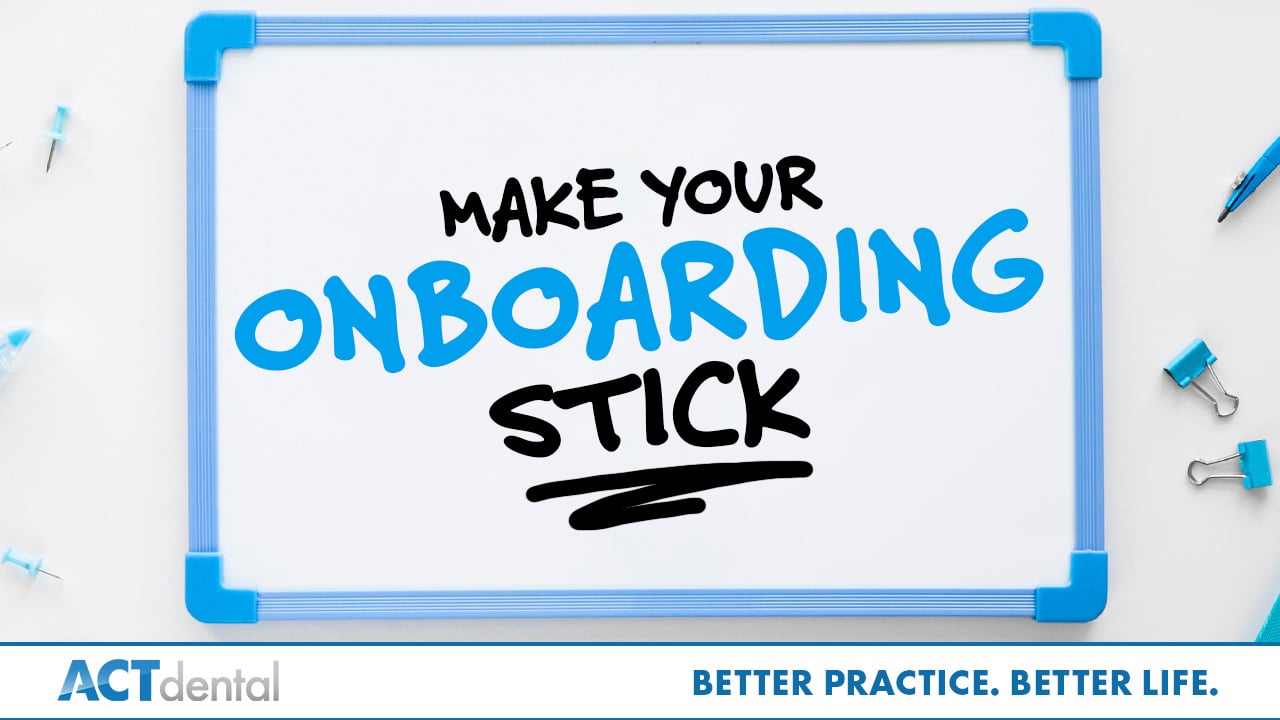Few things are more frustrating than pouring time and energy into hiring, only to watch your new team member walk out the door. When turnover is high, especially with new hires, it’s more than just inconvenient, it’s a costly, culture-draining problem. That’s why retention isn’t just important; it’s essential. Ultimately, 50% of retention comes down to your onboarding process, so when you get that component right, it makes a huge difference! A successful onboarding process leads to loyalty, trust, and long-term retention, instead of the confusion, frustration, and turnover you’ll find in practices that aren’t nailing this step. Instead of waterboarding your new hires with paperwork, onboard them the right way!
Start with Purpose
Whenever a new team member comes onboard, they’re overwhelmed with questions. What are the company’s purpose and values? What’s their culture like, and how do I integrate into that? Where is the company going? When you lead with your Core Values and Purpose, however, you can answer those questions before they’re even asked.
To facilitate this process, I recommend using our 3-3-3 Onboarding Tool. The first step is to learn about the practice over the first three days, which helps connect the new hire to the practice and its culture right away. We all want to feel like we belong somewhere, so instead of spending the first three days filling out forms and reading policy manuals alone, connect your new hires with your culture from day one.
Set Clear Expectations and Build Confidence
Once you’ve shown that the new hire belongs here by onboarding the purpose and values component, the next step is to show what they’re going to do, and that means setting clear expectations for their role. Expectations are crucial, because like Kirk says, “The only time we run into conflict is when expectations and reality aren’t met.”
Once again, the 3-3-3 Onboarding Tool will make this a breeze, as it will clearly outline attainable targets for the team member in the first three days, three weeks, and three months. This strategy enables the team member to achieve small wins early on, which builds their confidence to take on bigger challenges down the road. You should never expect a new hire to “figure it out” or “get it” on their own—that’s a mindset that will surely lead to problems. Instead, focus on helping them understand your expectations so they can grow and develop instead of merely surviving.
Create Belonging and Ownership
People want to stay where they feel like they belong, and when you fulfill this need, you’re going to drastically reduce your turnover. By starting with your culture and giving them a clear roadmap to success, you’re giving them a head start on this feeling of belonging. They must feel welcomed, and when you do this by confidently introducing them to the practice, their fellow team members, and their patients, you’re showing them that they have a place on your team. When you do this well, new team members will feel confident enough to contribute their opinions and truly start owning their role. Remember, early inclusion leads to long-term retention, and by making them belong, you’re ensuring they give their best to the practice.
One of the mistakes I see people make is approaching onboarding with the mindset that it should be efficient above all else. But onboarding isn’t just about efficiency—it’s about humanity and showing your new hire that they’re valued and you’re invested in their success. A successfully onboarded team member feels like they’re a part of something bigger: they’re confident, productive, and proud ambassadors of your brand, which will help the practice exponentially in the long-term.
To learn more about ACT and how we can help you build a Better Practice and a Better Life, reach out to Courtney!
Tune in next time and learn how to create partnerships that are truly aligned!
Adriana Booth
Adriana Booth is a Lead Practice Coach who partners with dentists and their teams to cultivate leadership skills, drive practice growth, and streamline business practices. With nearly three decades of experience in the dental industry, Adriana brings a deep passion for professional development, high-level training, and systems creation to her coaching. As a dental hygienist committed to continuing education and personal growth, she thrives on helping practices achieve their full potential. Adriana holds a BS in Dental Hygiene from West Liberty University/O'Hehir University and remains actively engaged in the dental community through study clubs and professional networks. Now based in Teays Valley, WV, Adriana enjoys fitness, reading, quality time with family, and exploring the outdoors with her Chesapeake Bay Retriever, Beau Duke.
RECENT POSTS
Data Snapshot: Diagnostic Percentage
December 05, 2025
978: Unfair Care – Dr. Bryan Laskin
December 05, 2025
The Secret To Getting Patients To Say Yes: Lead With The Headline
December 01, 2025
976 (877 Replay): Metric Mondays: What is Your “Production Story”? – Dr. Barrett Straub
December 01, 2025
4 Steps to Eliminate your Overdue Account Problems
November 28, 2025
975: Revenue Reality: Mastering Production & Write-Offs – Miranda Beeson
November 28, 2025
974: Where is the Profit Hiding? – Christina Byrne
November 26, 2025
What Really Holds You Together?
November 24, 2025
